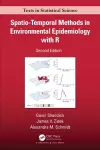
Spatio–Temporal Methods in Environmental Epidemiology with R
3 authors - Hardback
£97.99
Gavin Shaddick is a reader in statistics in the Department of Mathematical Sciences at the University of Bath. He received his master’s in applied stochastic systems from University College London and his PhD in statistics and epidemiology from Imperial College London.
His research interests include the theory and application of Bayesian statistics to the areas of spatial epidemiology, environmental health risk, and the modeling of spatio-temporal fields of environmental hazards. Of particular interest are computational techniques that allow the implementation of complex statistical models to real-life applications where the scope over both space and time may be very large.
Dr. Shaddick is actively involved in a number of substantive epidemiological projects related to the effects of air pollution to health. He has worked on many large-scale funded projects, including the high-resolution mapping of environmental pollutants, the utilization of information from multiple sources in estimating exposures to environmental hazards, and the characterization of uncertainty in scenario assessment and policy support.
He is a co-author of the Oxford Handbook of Epidemiology for Clinicians, which was Highly Commended in the Basis of Medicine Category, BMA Book Awards 2013.
James V. Zidek is a professor emeritus in the Department of Statistics at the University of British Columbia. Professor Zidek received his MSc and PhD in statistics from the University of Alberta and Stanford University, respectively.
He began his research career working on Wald’s statistical decision theory. That interest shifted into Bayesian decision analysis. His interest in applications also emerged early in his career and as a consultant, published with engineering collaborators, the first design code for long-span bridges, such as the famous Golden Gate Bridge in San Francisco. The combination of theory and practice led him to an EPA project on acid rain where he, with a few of his collaborators, started to lay the foundations of environmetrics as it is now called, notably on the design of environmental monitoring networks and spatio-temporal modeling of environmental processes. That work led naturally into spatio-temporal epidemiology, which remains an area of interest. He has published about 100 refereed articles and a book on modeling environmental processes.
His contributions to statistics have been recognized by a number of honors. He is a fellow of the ASA, IMS, and Royal Society of Canada; member of the ISI; and a recipient of the Gold Medal of the Statistical Society of Canada (its highest honor).